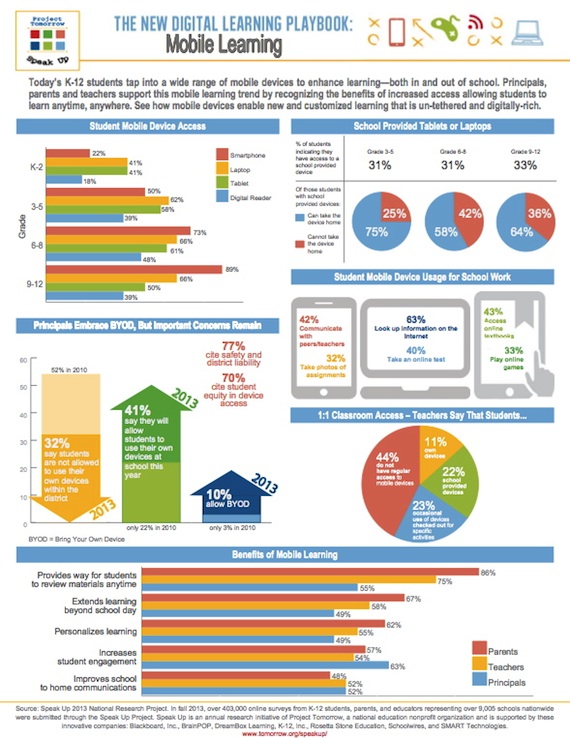One-Third of U.S. Students Use School-Issued Mobile Devices
New research indicates virtually all middle and high school students have access to mobile devices and are using them for schoolwork. And nearly a third of them are using mobile devices issued by their schools.
According to the report, "The New Digital Playbook: Understanding the Spectrum of Students' Activities and Aspirations," issued by Project Tomorrow in an event taking place in Washington, DC today, 89 percent of high school students (grades 9–12) and 73 percent of middle school students (grades 6–8) have access to smart phones. Another 66 percent in both groups have access to laptops. Sixty-one percent of middle schoolers and 50 percent of high schoolers have access to tablets. And 48 percent of middle schoolers and 39 percent of high schoolers have access to digital readers.
The report is part of Project Tomorrow's annual Speak Up survey, which to date has polled some 3.4 million students, teachers, administrators and parents on the use of technology in education. The latest survey was conducted in the last quarter of 2013 and is being released in conjunction with a Congressional briefing to be held Tuesday. Additionally, an assembly of students will discuss their views of the role of technology in education in a panel to be streamed at bit.ly/SUCB2014.
There's also significant penetration of mobile devices among the primary grades. Half of students in grades 3–5 have access to a smart phone, though only 21 percent of K–2 students can make that claim. Laptops and tablets are even more entrenched. Sixty-two percent in grades 3–5 have access to laptops, and 58 percent have access to tablets. In grades K–2, 41 percent have access to laptops and/or tablets. Thirty-nine percent in grades 3–5 have access to digital readers, 18 percent in grades K–2.
Among all high schoolers in the United States, 33 percent use school-issued mobile devices. A similar percentage of middle school and elementary students also use school-issued devices — 31 percent.
Among high schoolers in Title I schools, 32 percent use school-issued mobile devices. Thirty percent of middle school students in Title I schools also use school-issued devices. Twenty-five percent of elementary (grade 3–5) students in Title I schools use school-issued devices.
According to the report, most are using these devices for school-related work inside the classroom, including:
- Accessing class information through an online portal (75 percent of high schoolers, 68 percent of middle schoolers and 31 percent of grade 3–5 students);
- Taking tests online (52 percent of high schoolers, 47 percent of middle schoolers, 44 percent of grade 3–5 students);
- Using online textbooks (37 percent of high schoolers, 32 percent of middle schoolers, 14 percent of grade 3–5 students); and
- Watching teacher-created videos (22 percent of high schoolers, 22 percent of middle schoolers, 14 percent of grade 3–5 students).
Outside the classroom, most are also using their mobile devices for school-related activities. These activities include texting with classmates specifically about schoolwork (73 percent of girls and 60 percent of boys). Other activities include taking photos of assignments, finding videos to help with homework, videoconferencing with classmates about schoolwork (Skype or iChat) and collaborating over Facebook.
"In many ways, the new gateway to self‐initiated technology use for schoolwork is the mobile device," according to the report. "Increasingly, students have access to tablets and laptops to use both at school and at home for learning purposes. In some cases, parents are providing these devices to enable their children to have access to high quality digital content and be able to extend the learning process beyond the school day. In this year's Speak Up survey for parents of school‐aged children, almost two‐thirds of parents (64 percent) said they would purchase a mobile device such as a tablet or laptop for their child to use at school, if it was allowed. A similar percentage of parents (61 percent) said their preference is for their child to be in a class where they could use their own mobile device."

The complete report is freely available on Project Tomorrow's site.